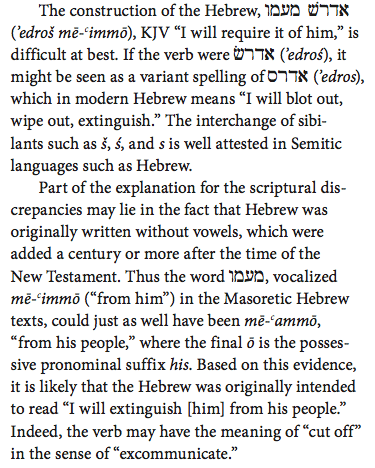The latest question added to my LDSFAQ (Mormon Answers) page on “Plagiarism and the Book of Mormon” involves an interesting instance of New Testament language being curiously present in Book of Mormon. The issue involves quotations of Deuteronomy 18:15-19 that seem closer to the language used by Peter in Acts 3 than the language of the Old Testament. The skeptic may then ask if that doesn’t that prove Joseph Smith was just copying from a modern Bible and not translating an ancient text? It’s a fair question.
The KJV of Deuteronomy 18:15—19 speaks of the Lord “requiring it of him” who rejects the Prophet the Lord will raise up in the future (the Messiah):
The Lord thy God will raise up unto thee a Prophet from the midst of thee, of thy brethren, like unto me; unto him ye shall hearken; According to all that thou desiredst of the Lord thy God in Horeb in the day of the assembly, saying, Let me not hear again the voice of the Lord my God, neither let me see this great fire any more, that I die not. And the Lord said unto me, They have well spoken that which they have spoken. I will raise them up a Prophet from among their brethren, like unto thee, and will put my words in his mouth; and he shall speak unto them all that I shall command him. And it shall come to pass, that whosoever will not hearken unto my words which he shall speak in my name, I will require it of him.
Deut. 18 is quoted twice in the Book of Mormon, both in 3 Nephi 20:23 and 1 Nephi 22:20, but with different language that more closely follows the way Peter quoted Deuteronomy in Acts 3:22-23. Instead of “requiring it of him,” the Book of Mormon passages speak of being “cut off from among the people” and Peter speaks of being “destroyed from among the people,” all more severe than the KJV for Deut. 18 and all involving “from among the people” instead of “of him.” Sloppiess by Joseph Smith, an inept plagiarizer?
Actually, this particular passage in Hebrew is complex and can plausibly have had an original meaning that Peter could rendered with “destroyed” or “cut off,” and “from among the people” instead of “from him.” See
“The Prophet Like Moses” by John A. Tvedtnes and E. Jan Wilson, Insights, The Maxwell Institute, Vol. 27, No. 5, 2007. To see the Hebrew, open the PDF file for the 2007 Insights publication and scroll down to the article by Tvedtnes and Wilson. They get into some interesting details, but here’s a key excerpt:
The authors explore both the issue of “cut off”/”destroyed” and “from among the people,” and find confirmation for their proposals by examining related passages in Ezekiel, for example. In light of the evidence, they offer this conclusion:
It seems clear that Peter rendered the Hebrew “from the people” rather than “from him.” Because this is not the reading of the Septuagint (usually cited in New Testament quotations of the Old Testament), and because it is dependent on the Hebrew text rather than the Greek, it is significant that the Book of Mormon scribes understood it in the same way that Peter did. Peter’s Hebrew source evidently read the same way as the Deuteronomy passage on the brass plates that Lehi carried out of Jerusalem about 600 BC.
Thus there is a plausible case for the Book of Mormon passages being derived from a reading of the ancient Hebrew text, not just some random passage from the New Testament. In light of that evidence, the Book of Mormon language may indeed be “significant.” If Joseph were a plagiarizer, why on earth borrow a New Testament paraphrase of Deuteronomy when the KJV text was right under your nose? What we have is actually plausibly consistent with the theory of an ancient Semitic understanding of Deut. 18 perhaps shared both by Peter and the editors of the brass plates that the Nephites had with the Hebrew scriptures. Not proof of anything, but hardly a horrific blunder that destroys the Book of Mormon. It’s one of those things like the awkward language of the original text or the wordiness of, say, chiasmus, that rather than pointing to a weakness, may reflect the strength of ancient Semitic origins.
Update, Nov 16, 2012: However, as a friend of mine points out, 3 Nephi 20 continues with more language from Acts 3. It seems there is simply New Testament text being used in the translation. Brant Gardner in his former online commentary of the Book of Mormon noted that this is clearly an artifact of the translation process. Just what that process was and how text was quoted and used as a translation aid is open to speculation.










